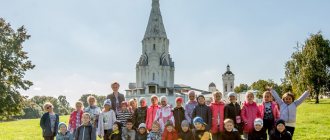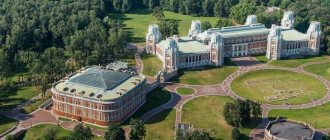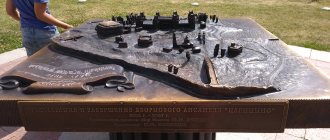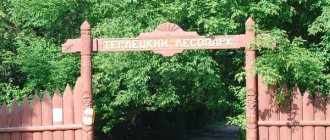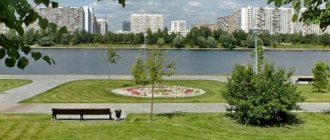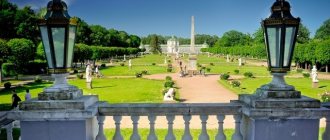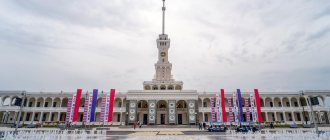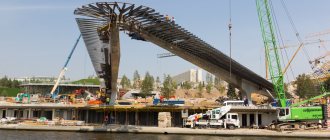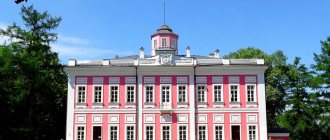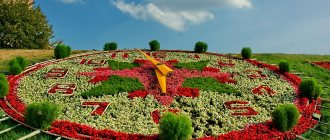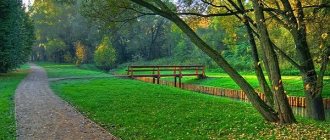Lefortovo Park is a large ancient park in Moscow that remembers historical events dating back to the 18th century. The architecture conveys the atmosphere of those times, and beautiful picturesque places near green trees and ponds attract the attention of visitors. The place is equipped for recreation, both active and relaxing, staying with children. Numerous events and excursions have made Lefortovo Park a popular place in Moscow, where all residents of nearby areas and tourists who are interested in the historical past of the country come together.
A natural monument of landscape art and architecture of historical significance, Lefortovo Park was built back in the 18th century in Moscow and changed its name several times (Versailles on the Yauza, then Golovinsky Garden). It is located in the Lefortovo district of Moscow and is adjacent to the Catherine Palace.
© pavelodinets
ADDITIONAL INFORMATION: ADDRESS. TELEPHONE. HOW TO GET THERE
Address: Moscow, Krasnoznamenaya street, 3
Opening hours: Daily from 5:00 to 23:00
Lefortovo Park is one of the oldest natural monuments in Moscow. Its peculiarity lies in the fact that it combines a dense, diverse flora and historical architectural structures built under Catherine II. The flora combines perfectly with picturesque objects built in the 17th century and preserved to this day. For many Moscow residents, this is a great place to be alone with nature.
Story
The history of this park begins in 1703, when Field Marshal Fyodor Golovin ordered its construction in honor of Franz Lefort (adviser to Peter I). The model for the construction was Versailles Park in France. Local residents even gave the Russian version the name “Versailles on the Yauza”. Peter I liked this park. He decided to buy it and make a Moscow residence there. In 1723, the ruler ordered Nikolai Bidloo to arrange the park in the Dutch style. A huge amount of work was done to improve the area: paths were made, stream flows were changed, sculptures and other decor were installed everywhere.
In 1730, the coronation of Anna Ioannovna was held in Lefortovo Park. This place made a huge impression on her. She decided to make Lefortovo her main residence, changing the name to "Annengof".
For the construction of the summer palace, the Empress attracted the famous architect Bartolomeo Rastrelli. The construction was made in the architect’s favorite style – Baroque. In order for Anna Ioannovna to live in the residence in winter, the Winter Annengorf was brought from the Kremlin. The architect was also involved in landscaping the park itself. Sculptures of Father Rastrelli were exhibited near the residence. In 1742, Anna Ioannovna’s cousin, Elizaveta Petrovna, ascended the throne. She ordered the park to be returned to its former name “Golovinsky Garden”, and also makes it open to ordinary people. She gave the order to build a theater, church and palace on the territory of the park according to the design of the architect Ivan Korobov.
Due to frequent fires, the palaces burned and had to be constantly restored. In 1773, Catherine II ordered the construction of a brick palace on the site of the wooden Annenhof. After the death of the Empress, the park was given over to the military. The palace housed barracks, and parade grounds were installed throughout the territory. The purpose of the park did not change during Soviet times. The palace housed a military academy for armored forces. It is worth noting that in those years a stadium was built on the territory of Lefortovo, which still operates to this day. In 2005, Lefortovo Park was transferred to the status of a museum-reserve.
Landscapes and architecture of the estate
In the park itself and its surroundings you can see several monuments to Emperor Peter the Great.
The earliest of them is located on the shore of the pond and is a small gazebo with columns by Matvey Kazakov, which is accompanied by the inscription:
“The monument to the resting place of Emperor Peter the Great was built in 1805. This monument was destroyed by a hurricane on June 16, 1904 and re-founded on August 26 of the same year. His Imperial Highness Grand Duke Konstantin Konstantinovich and His August sons Princes John, Gabriel and Konstantin Konstantinovich."
Now in the rotunda there is a bust of the emperor, on the pedestal of which there is a quote from his letter of 1724 that he would like to sail from St. Petersburg along canals and rivers directly to the Golovinsky Garden. This was one of Peter’s last grandiose dreams, which came true in another era.
At the very end of the twentieth century, another unusual monument was erected at the entrance to Lefortovo Park - an obelisk made of granite with bronze reliefs, one of which depicts two energetic figures - Tsar Peter and his associate Franz Lefort.
This work by sculptor Elena Surovtseva shows the heroes in a romantic image during the period of Peter’s youth, when great achievements and glorious victories await them.
The third monument to Peter, also not trivial, the most inquisitive can see in the park of the hospital named after N. Burdenko, which is located next to Lefortovo Park, for which you need to go to Gospitalnaya Street and go deep into the hospital garden. There, already at the beginning of this century, the sculptor Leonid Baranov created the sculptural group “Peter and Nikolai Bidloo”.
The fact is that Bidloo was not only a landscape architect, the author of the Golovinsky Garden, but also a physician, the founder of clinical medicine in Russia. On his initiative, not only Versailles on the Yauza was created, but also the Moscow Hospital with the first medical school in the country.
This is how, walking around Lefortovo, you can see Peter in three images, at three ages and in three different sculptural incarnations.
The most valuable architectural monument in Lefortovo Park is the Grotto , the author of which is Francesco Bartolomeo Rastrelli, whose works are very rare in Moscow. The grotto was built in 1731 from brick with white stone columns covered with carved decorations.
Initially, according to the architect's plan, its elements included fountains with 12 gilded dolphins, a statue of Hercules and gilded sphinxes. But the sculptures have not survived to this day; now you can only see the lower part of the building with Baroque decor and niches.
The grotto still gives the impression of a mysterious structure, which, reflected in the dark waters of the old pond, creates a romantic mood, plunging us into ancient eras. The introduction of untreated rough stone into the brickwork gives the Grotto a brutal, even primordial character - this place is still secluded, very emotional and even alarming.
Having visited Lefortovo Park, you should definitely see the Catherine Palace - this is the most significant monument preserved on the territory of Lefortovo from the 18th century. The palace has a difficult history of construction and an equally difficult history of existence.
The construction of the palace began in 1773 according to the design of Catherine’s favorite architect Antonio Rinaldi, but subsequently the construction did not work out, the project had to be redone, and the construction was headed by Karl Blank, the author of the buildings in the Kuskovo estate, then the famous Quarenghi.
As a result, the palace took 25 years to build until 1797; the empress never saw it completed. Paul I did not like his mother's palace, and immediately after the death of the Empress in 1796, the building was turned into barracks for the Moscow Garrison Regiment. The decoration of the main rooms, including the throne room, was significantly simplified.
There was a parade ground in front of the building. This place began to be called the Red Barracks. In the 19th century, the Moscow Cadet Corps and Alekseevsky Military School were located in the palace premises. During Soviet times, the building was also under the jurisdiction of the Ministry of Defense and housed the Academy of Armored Forces.
Negotiations on the transfer of the building to the city and its further museumification are still ongoing with the military department. In the architectural appearance of the facade, the influence of Giacomo Quarenghi is most noticeable; he decorated the facade with an extended loggia, which includes a portico of 16 columns of dark “wild stone” (gray sandstone).
Despite some later reconstructions, it can be confidently noted that the complex of the Catherine Palace in Lefortovo, with its extensive facades of rich red color and courtyards, represents one of the most significant buildings of Russian classicism.
Attractions
Since the time of Anna Ioannovna’s life, many cultural values have been preserved in the park. One of the main attractions of Lefortovo is the Rastrelli Grotto. This architectural structure was originally built by Nicholas Bidloo, but in 1731 Rastrelli changed the design of the grotto. He installed white stone columns there and also added many sculptural elements. Unfortunately, none of these statues have survived to this day. The Gazebo-Rotunda is also attractive to visitors. The building is made in a semicircle, and the roof rests on eight granite columns. In the center of the gazebo there is a monument to Peter I. During a hurricane in 1904, the structure was destroyed. On August 26, 1904, Prince Konstantin Konstantinovich issued a decree to restore the gazebo. In this form it has been preserved to this day. The largest building that has reached us is the Catherine Palace. Now it houses the department of military structures. The building is closed to the public. One of the few attractions that has been preserved in its original form is Linden Alley. This is a great place to take some photos with nature as a backdrop.
Moscow.org Moscow city portal
| All photos |
Address: st. Krasnokazarmennaya, 3 building 1
Opening hours: from April to October from 7:00 to 22:00 from November to March from 7:00 to 21:00
How to get to Lefortovo Park: st. m. Aviamotornaya, then troll. 24 to the stop. Lefortovo Park
Lefortovo Park, also known as Golovinsky Garden, is the first regular park in Russia, designed in the Dutch style, which was then modeled on many parks in St. Petersburg. This park was founded by Peter I in 1703, and it was named in honor of the emperor's associate Franz Lefort. Lefortovo Park is a natural and historical monument. Next door is the Catherine Palace in Lefortovo, the main imperial residence of the 17th century. The palace and park complex also includes the Golovinsky Palace, various service buildings and buildings. From the original Dutch layout, a linden alley, a rotunda gazebo, five ponds, benches and a grotto designed by the architect F.B. Rastrelli have been preserved to this day. The main alley of the park runs along the bridge dividing the park ponds. There is a gazebo on the shore of one pond.
In the distant past, in this area there were settlements of artisans and traders from different countries, which were called the German Settlement. The first documentary mentions of these settlements date back to the 16th and 17th centuries. After the Livonian War, many foreign prisoners appeared in Moscow, who were allocated a place to live on the Yauza River near the Kukuy stream. If you thought that the German Settlement was inhabited only by Germans, this is not so, Muscovites called all foreigners who spoke Russian poorly Germans, from the dumb, unable to speak. Over its long history, the German Settlement in Moscow burned, then it was rebuilt closer to the city center, and in 1652, Tsar Alexei Mikhailovich issued a decree to again evict foreigners from Moscow. The New German Settlement quickly developed, several churches appeared here, and the area began to look like a small corner of Europe near Moscow. Peter I himself was a frequent guest in the homes of residents of the German settlement.
The stone Lefortovo Palace in a German settlement was built by D.V. Aksamites at the expense of the emperor in 1698, and then the building was transferred for temporary residence to Admiral Lefort. The palace building was built in an eclectic style, combining elements of Western European architecture with tower buildings and the first elements of Peter the Great's Baroque. It is generally accepted that this was the first attempt to move away from pre-Petrine techniques in Russian architecture. The ceiling height in the reception hall was 10 meters, and the area was 300 square meters. It could accommodate 1,500 people at the same time. According to contemporaries, one room in the palace was covered with green leather and furnished with valuable cabinets, another contained objects of Chinese work, and another was decorated with silver damask brocade and a high bed with red curtains. There was another unusual room in the palace, decorated with paintings on a marine theme, from the ceiling of which hung a galley and other ships.
Lefort himself wrote: “There are ponds in the garden, which are not easy to find here, and there are a lot of fish in them. On the other side of the river I have a park where there are a variety of wild animals. My house is the most beautiful and most pleasant of all in the neighborhood; the people of this country come here to see it as a rarity.” The main entrance to the palace faced the river.
Let's tell you a little more about the first inhabitant of the palace. Franz Yakovlevich Lefort was born in 1656 in Geneva. He arrived in Moscow in the mid-1670s with the rank of captain, and settled in the German settlement in Moscow. His further fate was such that he learned Russian, married the daughter of Lieutenant Colonel Suge Elizabeth, became the first admiral of the Russian fleet and a person especially close to Peter I. Franz Lefort took part in the Crimean campaigns of the late 1680s, in the Azov campaigns, commanded the 1st Moscow Regiment, called Lefortov. To accommodate this regiment, a parade ground was set up on the opposite bank of the Yauza River, opposite Leforto’s house, and then Soldatskaya Sloboda was built, later renamed Lefortovo. The settlement consisted of 500 houses located in even regular rows-streets.
Lefort celebrated his housewarming in February 1699, and just three weeks later, at the age of 46, he died. After this event, the palace passed into the treasury, and Peter I received foreign ambassadors there, held balls, assemblies and theatrical performances. In the winter of 1706 it was transferred to A.D. Menshikov, along with a substantial amount for completion. In 1708, an Italian architect (presumably Mario Fontana) added several buildings along the perimeter of the courtyard, a monumental main entrance, and redid the facades of the palace. Under the new owner, a park with ponds was transformed behind the house, which stretched across the Yauza to its other bank.
In 1702, one of the closest associates of Emperor Peter I, Fyodor Alekseevich Golovin, acquired a plot of land on the right bank of the Yauza opposite the German settlement. In 1703, the architect D. Ivanov built a palace for Golovin with a garden and a rectangular pond located on a stream (Golovinsky Pond). In the garden there was an entertainment pavilion and a fountain. This is how the Lefortovo palace and park complex continued to form.
When, during the short reign of Peter II, the transfer of the capital from St. Petersburg back to Moscow began, the Lefortovo and Golovinsky palaces housed the royal court. The betrothal of Peter II and Ekaterina Dolgorukova also took place in the Lefortovo Palace. But the wedding was not destined to take place. The Emperor fell ill with smallpox and died on his wedding day, January 18, 1830.
In 1731, next to the Golovinsky Palace, designed by architect F.B. Rastrelli built the Summer Annenhof for Empress Anna Ioannovna, and in 1736 the Winter Annenhof appeared here, after which the palace and park ensemble became the permanent residence of the imperial court.
During the reign of Elizabeth Petrovna, this residence was called the Golovinsky House, in memory of the first owner of the estate and associate of Peter I. These buildings, made in the Baroque style, have not survived to this day. On the site of the Summer Annenhof is the Catherine Palace, and where the Winter Annenhof once stood, Krasnokazarmennaya Street runs.
In 1737, during a major fire in Moscow, the Lefortovo Palace was significantly damaged and had to be rebuilt. By that time, an extensive regular Annenhof Park with an extensive system of canals, ponds and fountains had formed around the Lefortovo and Golovinsky palaces. It was the largest park in Russia.
In 1742, Elizaveta Petrovna stayed in Lefortovo after her coronation. Especially for this event, architect A.P. Evlashev erected a new wooden winter palace on the site of the old Golovinsky Palace. A wooden Resurrection Church was built next to the building. According to the design of the architect F.B. Rastrelli built an Opera House in his personal garden, which had four tiers of boxes and an Illumination Theater. During the reign of Elizabeth, Annenhof still remained an imperial residence, but in 1744 it was given back its old name - Golovinsky Estate.
In 1753, Annenhof was almost completely burned down during a fire, and in 1773, on the orders of Empress Catherine II, the Catherine Palace began to be built in its place. But the construction work was completed only in 1796, and the empress never visited her new Moscow palace. During the long history of the existence of the Golovinskaya and Lefortovo estates, a plague quarantine was also located on their territory (1771), there was a residence for posts of foreign powers, and the premises were also rented out for housing to theater actors. A military archive has been operating here since 1804. Since, by decree of Emperor Paul I, the Catherine Palace was given to the Moscow garrison regiment, and from then until 1917, barracks and various military educational institutions were located in the Catherine Palace.
Nowadays, Lefortovo Park has become a popular vacation spot in Moscow. At the end of 1999 and the beginning of 2000, construction and hydraulic engineering work was carried out in the park, in parallel with which architectural and archaeological research was carried out. As a result of research work, it became possible to clarify the historical layout of the park. It became clear how the paths, platforms, stairs, etc. were previously located. Among the unique finds there are many carved white stone fragments of the decoration of the retaining wall of the Annenhof Palace, which is considered the first work of the great F.B. Rastrelli in Russia. The Lefortovo tunnel of the Third Transport Ring runs under the park. During the Soviet years, Lefortovo Park was renamed the Park of the Moscow District Officers' House (MVO Park).
In 2005, Lefortovo Park became part of the Moscow State United Art Historical-Architectural and Natural Landscape Museum-Reserve. Also included in the reserve were Kolomenskoye, Izmailovo and Lyublino.
A special attraction of Lefortovo Park are the ponds. Here, even today, you can not only relax, but also go fishing. The ponds are located in the lower and middle reaches of the Sinichka River. All of them have a name: Boot, Bath, Square, Guitar, Island, Northern. The park is also perfect for walking with children - on ordinary days it is very quiet and peaceful. In 1934, a stadium was opened on the territory of Lefortovo Park, which still exists today. The park often hosts various themed events, during which everyone can become spectators of theatrical performances or take part in a historical excursion. On such days, a brass band plays for visitors, performing military melodies from different years.
You can get to Lefortovo Park through the main entrance, located from Krasnokazarmennaya Street or from three others: Golovinskaya Embankment, Hospital Street, Hospital Square.
Park life
The life of the park is full of colorful events and entertainment. Various events, excursions and even a brass band play here every day. The entire park is landscaped for family recreation. Here you can rent a bike and go explore the nature of the place. There are six ponds throughout the area, and each of them has its own name. Swimming in these reservoirs is prohibited, but you can sunbathe and fish. For lovers of an active lifestyle, there are many sports grounds and jogging paths in the park.
Recreation and entertainment in the park
From the original layout of landscape architect Nicholas Bidloo, the author of the Golovinsky Garden, all that remains is a linden alley and six ponds that connect underground canals. Each pond has its own name: Sapozhok, Banny, Severny, Kvadratny, Guitar, Ostrovnoy.
Walking along the picturesque alleys of the park and the banks of reservoirs is the main type of active recreation in Lefortovo. All Lefortovo ponds contain fish, which attracts fishermen. Swimming in the ponds is prohibited, but you can sunbathe here. And on warm sunny days, all the banks are strewn with people basking in the sun.
Lefortovo Park is intended more for educational family recreation. Interesting lectures and excursions are held in the reserve. The guides talk about the emergence and development of the estate, the periods of the reign of Peter I and Empress Elizabeth Petrovna, the charitable mission of Lefort and his entourage.
You can learn about the history of the Moscow Cadet Corps, the birth of the Russian Navy and many other fascinating topics related to the history of Russia.
Among other events, there are interactive educational classes, quizzes, talks about exhibits, and shows photographs and videos of historical events related to the estate.
Various festive theatrical events and historical excursions are often held here, a brass band plays, and sports competitions are organized.
